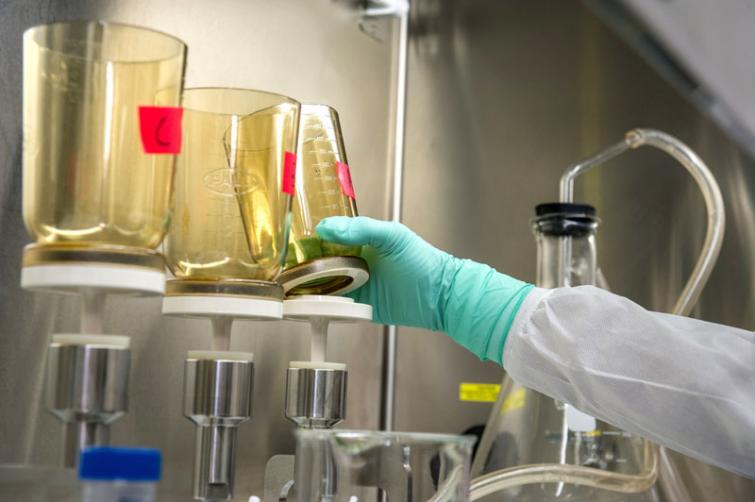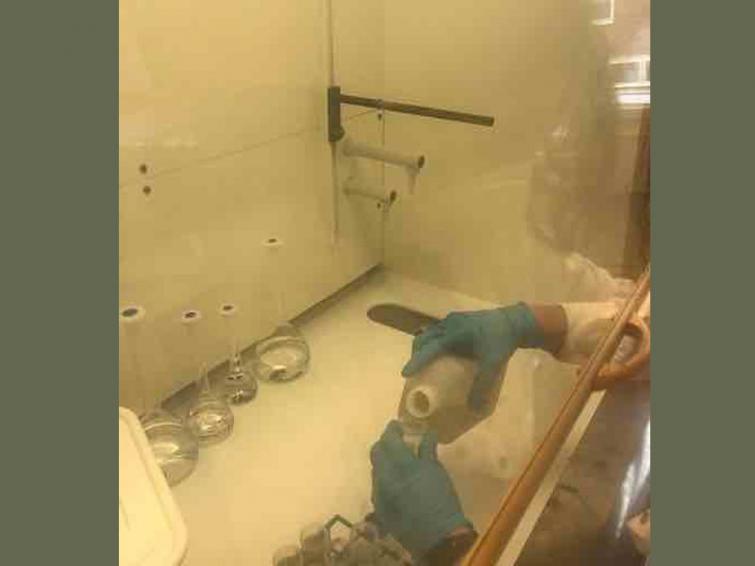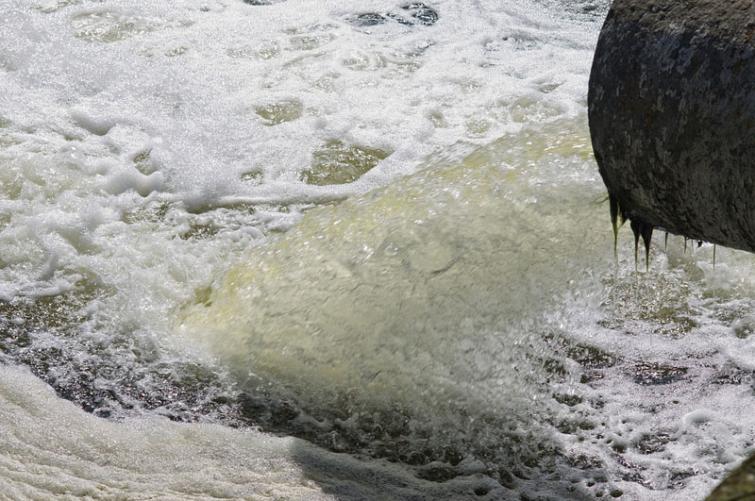
Researchers are in the preliminary stages of investigating wastewater for the presence of the novel coronavirus as an environmental surveillance mechanism, reports Mongabay-India correspondent Sahana Ghosh
Scientists around the world are peeping into poop and wastewater for the novel coronavirus (SARS-CoV-2) to come up with surveillance techniques to warn if the virus is circulating in a city or municipality.
SARS-CoV-2 is responsible for the pandemic of the Severe Acute Respiratory Syndrome (COVID-19).
Scientists say tracking wastewater for the novel coronavirus SARS-CoV-2 can serve as an early warning system alerting the public health community to when and where infections are prevalent and if the virus is re-emerging in communities. They stress that “too little is known about the possible infectious activity of coronavirus (SARS-CoV-2) particles in sewage water.”
Among the several research groups, an international collaborative led by Swedish researchers including Indian scientist Manish Kumar of IIT-Gandhinagar says the ongoing pandemic offers an occasion to field-test the hypothesis that wastewater-based epidemiology (WBE) can be used to observe and manage public health in almost real-time, at a global scale.
The consortium intends to gauge the scale of infection in a population by collecting and examining influent samples from municipal wastewater treatment plants in several countries including in India. They will quantify the viral RNA excreted in faeces, and extrapolate the number of infected people in a population from concentrations of viral RNA in wastewater samples.
“We will have a standard protocol for collecting samples and doing the laboratory analysis. The main motive of our study is to understand the transmission mechanism of COVID-19 from an infected person to the sewage and from sewage to humans again,” Manish Kumar of the department of earth sciences at IIT-Gandhinagar, told Mongabay-India.
Based on literature reports the collaborating scientists are trying to understand more how environmental factors (air, water, and soil) shape the virus’s transmission in the environment and also its phylogenetic relationship with other viral families.
“We are focusing on developing full-fledged isolation and identification techniques for COVID-19 not only restricted to wastewater but also for potable water and soil systems. Additionally, we are also aiming to develop a methodology for laboratory studies to estimate the occurrence of SARS-CoV-2 virus in wastewater and to use this data for screening the population affected,” said Manish Kumar.
“Routine wastewater surveillance could be used as a non-invasive early-warning tool to alert communities to new COVID-19 infections,” he added.
The detection of the presence of SARS-CoV-2 in wastewater in the early stages of the local outbreak by scientists further supports its use for WBE, said Prosun Bhattacharyaat KTH Royal Institute of Technology, Stockholm, Sweden.
Explaining the premise, Bhattacharya who initiated the collaborative work with Zeynep Cetecioglu Gurol at KTH, said recent studies have indicated that infection with SARS-CoV-2 is frequently accompanied by persistent shedding of the virus – not only in human stool but also in urine, human saliva, spit or cough.
“The shedding of SARS-CoV-2 in stool, urine and mouth washing raises the potential to use WBE approaches for SARS-CoV-2 surveillance and epidemiological monitoring,” Bhattacharya told Mongabay-India.
This approach is especially useful given that most infections are thought to be asymptomatic or undiagnosed infections and therefore are not captured in limited clinical surveillance, said Zeynep Cetecioglu Gurol.
“In lieu of clinical data, wastewater monitoring may provide critical information on infection dynamics, alerting the public health community to when and where infections are prevalent,” said Gurol.
Sewer as a ‘mirror of the population’
In a preprint (that has not been peer-reviewed) published on March 30, KWR Water Research Institute researchers in the Netherlands, said even before COVID-19 patients appeared, the sewage data (first from Amersfoort and then from Terschelling) made it clear that the virus was present in the population.
In an update on their website, KWR researchers said that in the case of sewage, one test is sufficient to determine whether an entire population is infected with the coronavirus. The advantage of this method is that it is very specific and sensitive. “We test whether the virus is circulating in a city or municipality, not who is or who is not infected within that population,” they said.
In the Netherlands, but also in other countries, samples are collected from the sewer network to detect hereditary material (RNA) of the COVID-19 virus in wastewater with the aim of using the sewer as a “mirror of the population” said Frederic Been of COVID-19 team at KWR Water Research Institute.

“The entire city can be screened with one sample using the sewage water that arrives at the wastewater treatment plant,” said Been.
“The fragments of genetic material (RNA) detected from sewage are very quickly decomposed in sewage water and will only be stable if protected by the protein coat (capsid), meaning only if the whole virus is present. Therefore, demonstrating these specific RNA fragments in sewage wastewater implies whole virus particles were present,” Been told Mongabay-India.
Exposure to SARS-CoV-2 in wastewater could pose a health risk, said Centre for Infectious Disease Control, National Institute for Public Health and the Environment scientists in a scientific correspondence on April 1, adding that environmental surveillance of SARS-CoV-2, the virus that causes COVID-19, could serve as a data source, indicating if the virus, is circulating in the human population.
In a paper uploaded to preprint server on April 7 that has not been certified by peer review, scientists tested wastewater collected at a major urban treatment facility in Massachusetts, in the United States and found the amount of viral particles in wastewater observed was significantly higher than expected based on clinically confirmed cases in Massachusetts as of March 25. The reason for the discrepancy is not yet clear, however, and until further experiments are complete, these data do not necessarily indicate that clinical estimates are incorrect, the researchers note.
Since the coronavirus pandemic is recent, much of the medical research on it is preliminary and ongoing. Several studies are yet to be peer-reviewed, a step in scientific publishing which evaluates and verifies the study and makes it suitable for publishing.
Been said that too little is known about the possible infectious activity of coronavirus (SARS-CoV-2) particles in sewage water. However, from the information available so far, it does not seem very likely that coronavirus particles in wastewater can infect people.
“Sewage water has not yet been described as a transmission route and the risk is estimated to be very low. The virus concentrations in sewage water and aerosols generated from sewage water are probably much lower than what an infected patient exhales,” added Been.
“There are examples from previous work. Residents near wastewater treatment plants (WWTP) have been investigated on infections by water-transmissible viruses. This did not reveal that waterborne viral diseases were occurring more frequently. The strict quarantine in Asian cities has worked, while sewage and purification have not been ‘quarantined’. So no indication that WWTPs or aerosols play a role.”
Environmental surveillance for focussed COVID-19 testing
Punyasloke Bahdury at IISER-Kolkata’s department of biological sciences, who was not involved in the waste water-based studies, said environmental surveillance could also drive targetted testing.
“Globally it is a very challenging exercise for medical and biomedical professionals to practically and effectively screen a large number of individuals with suspected SARS-CoV-2 infection due to constraints in testing technologies. It is more so in many countries with a significantly higher population,” Bhadury told Mongabay-India.
“This type of surveillance can ultimately help towards focusing targeted testing in areas where surveillance will show signal and persistence of SARS-CoV-2,” Bhadury said.
Krishna Khairnar, head of the environmental virology cell at CSIR-National Environmental Engineering Research Institute agrees with the early warning benefit.
“The novel coronavirus is a respiratory virus and its mode of entry is through the respiratory system. But monitoring COVID-19 particles in wastewater can be used as an early warning system because wastewater is basically a drainage system for any pathogen in general,” Khairnar told Mongabay-India.
Environmental surveillance, for example, sampling of sewage has been used successfully in monitoring enteric virus circulation such as hepatitis A, adenovirus among others.
In India, sampling of sewage helped to characterise the epidemiology of poliovirus circulation during the country’s polio eradication program and it is still a key method of detecting poliovirus, Khairnar adds.
“Detection of hepatitis A virus, rotavirus, and norovirus including those linked to gastroenteritis in wastewater have been ongoing for some time in different parts of the world as an early warning of outbreaks. In South Asia, particularly India, wastewater surveillance of viruses is yet to be fully explored,” stressed Bhadury.
Meanwhile, researchers have also called for more testing to determine whether water treatment methods are effective in killing SARS-CoV-19 and coronaviruses in general.
Waste-water based analysis needed in South Asia, but tricky
Wastewater (sewage) is a mixture of human excreta, suspended solids, debris and a variety of chemicals that originate from residential, commercial and industrial activities. Raw sewage is a major carrier of several disease-causing agents, particularly enteric pathogens, and several viruses, said Arslan Ahmad, a research scientist in KWR’s Water Systems and Technology Research Group.
Referring to the Joint Monitoring Programme (JMP) for Water Supply and Sanitation by WHO and UNICEF data for 2017, Md. Tahmidul Islam, a research engineer at KTH and part of the Swedish collaborative, said developing countries are most vulnerable in the context of wastewater based epidemiology.
“Looking at the recent JMP data (WHO/UNICEF, 2017), around 20 percent people are still defecating in the open in the central and southern Asian regions. Urban areas have safe, managed sanitation services but the rural areas don’t have access to these improved services,” Islam noted.
“A prolific growth in pit latrines worked as a quick solution for human excreta disposal systems in low-income countries as an accomplishment of the Millennium Development Goals (MDG). These have been a concern for potential groundwater contamination. And the hydrogeological conditions play an important role in the transport of viruses through the aquifers and therefore might impact drinking water safety,” explained Ahmad.

However, for environmental surveillance to work more effectively, robust sampling strategies along with subsequent detection methods are of utmost importance, pointed out Bhadury.
“For example, in hospital, indoor environment surveillance, air sampling, exhaled condensate, ward door handles along with cleaning routines need to be examined,” Bhadury added.
Khairnar said interpreting data collected from Indian wastewater treatment systems may be tricky.
“In Western countries, where the data on the capacity of the wastewater treatment plant is quite robust, as in what area and size of the population it caters to, you can draw conclusions and get the full picture of the presence of the virus in that population. Particularly, in urban setups where wastewater treatment is well defined and regulated, that helps you in making sense of the surveillance data,” said Khairnar.
But in India, where wastewater treatment systems are often underperforming and may be overloaded, making logical interpretations of data could be difficult.
“Wastewater is a difficult source sample because it has all of the impurities that need to be taken care of first. The virus is a nanoparticle. So it will be very difficult to analyse that. Dilution of samples is a big factor because it could be tricky to detect the presence of the virus in diluted samples,” Khairnar added.
Joakim Larsson, director of the interdisciplinary Centre for Antibiotic Resistance Research at the University of Gothenburg, said wastewater based surveillance might work, but the precision and sensitivity (detection limit) are still not known.
“It may very well be a way to compare how common the infection has been in a society over time, in hindsight. If the precision is reasonably good, and when evaluated against other more direct surveillance methods, one could potentially get a rather unbiased snapshot of the current spread in a community within one or a few days after taking a sample. But we are not there yet,” Larsson added.
Support Our Journalism
We cannot do without you.. your contribution supports unbiased journalism
IBNS is not driven by any ism- not wokeism, not racism, not skewed secularism, not hyper right-wing or left liberal ideals, nor by any hardline religious beliefs or hyper nationalism. We want to serve you good old objective news, as they are. We do not judge or preach. We let people decide for themselves. We only try to present factual and well-sourced news.







